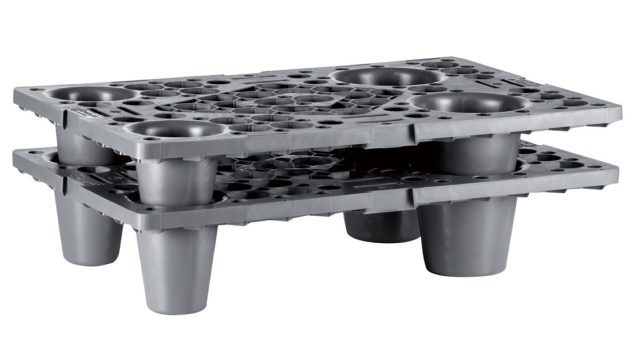
The Pallet Report 2024: A Comprehensive Overview of Pallet Usage Trends
Plastic and wooden pallets are an essential element of warehouse and distribution centre (DC) operations, serving as the backbone for the receipt, storage, and transportation of goods. With their role critical to ensuring a smooth and efficient supply chain, the pallet industry is always evolving. The Pallet Report 2024 provides valuable insights into how businesses are using pallets, their material choices, and the latest trends influencing the industry.
In 2024, 174 readers of Modern Materials Handling participated in a survey conducted by Peerless Research Group to understand the current pallet landscape. The findings reveal the importance of pallet choices in streamlining supply chain operations, improving sustainability, and managing costs. You can read that report here.
Key Areas of the Report
The report focuses on several essential aspects of pallet usage, including:
- Types of pallets in use or planned for future use
- Factors influencing the choice of pallet material
- Usage of new vs. used pallets
- Pallet rental services and international shipping practices
- Future expectations for pallet usage patterns
Dominance of Wood Pallets
The 48 x 40-inch wood pallet remains the industry standard and is used by 94% of surveyed companies, maintaining its popularity due to its cost-effectiveness, wide availability, and suitability for various industries. However, alternatives like plastic, composite wood, metal, and cardboard pallets are gaining traction, reflecting a gradual shift towards more diverse materials.
The study found that plastic pallet usage is on the rise, with 43% of respondents using them, up from 38% the previous year. This growth is driven by increased customer demand, sustainability concerns, and regulatory compliance. Companies are also exploring different sizes, with some opting for non-standard dimensions such as 48 x 48 or 42 x 42-inch pallets to better suit their specific operational needs.
When it comes to wood pallets, companies often opt for a mix of new and used options. Around 51% of businesses purchase new wood pallets, while 70% acquire used or core pallets. Interestingly, there has been a noticeable uptick in pallet pooling services, with 17% of respondents using such services, up from 15% last year and 8% in 2022. The increasing popularity of pallet pooling highlights a shift towards more sustainable and cost-effective solutions.
Despite the growing reliance on used pallets, concerns persist regarding their quality and availability. Roughly 29% of companies report that used pallets have become more expensive, while 28% find that the quality of used pallets has deteriorated. Nevertheless, 31% of companies do not foresee any issues with continuing to use second-hand pallets.
Plastic Pallets: A Growing Trend

Plastic pallets have become a key focus in the pallet industry, with several companies reporting increased usage due to customer demand and sustainability. Although 67% of respondents reported using the same number of plastic pallets as last year, a significant 28% noted that customers are requesting more plastic pallets. Companies are drawn to plastic pallets for their durability, ease of cleaning, and compliance with regulations, especially in industries like pharmaceuticals and food production, where hygiene is paramount.
Interestingly, 65% of companies anticipate no change in plastic pallet usage in the coming year, while 16% expect an increase, and 18% foresee a decline. Those looking to increase usage often cite sustainability as a driving factor, as plastic pallets can be recycled or reused, making them a more environmentally friendly option compared to wood.
Unit Load Stability and Pallet Packaging
Maintaining the stability of goods loaded onto pallets is another critical aspect of the report. To secure these loads, companies rely on a range of packaging solutions, including corrugated boxes, bags, drums, and plastic totes. Of those surveyed, 30% reported experiencing unit load stability issues, with many encountering such problems weekly or monthly. Common methods to stabilise these loads include stretch film (65%), shrink film (42%), and strapping (39%).
The standardisation of load stabilisation processes is also highlighted in the report, with 46% of companies following standardised practices. However, there remains room for improvement, as 17% of respondents admitted that their load stabilisation methods were lacking, and 10% reported having no standardisation at all.
Automation plays a vital role in wrapping operations, with 46% of respondents relying entirely on manual wrapping, 24% using semi- or fully-automated machines, and 26% employing a combination of manual and automated systems.
The Rise of Pallet Rental Services
Pallet rental services are slowly gaining popularity, with 14% of companies indicating that they currently use such services, an increase from 8% in the previous year. This shift suggests that businesses are increasingly open to outsourcing their pallet needs, benefiting from the flexibility and cost savings that rental services offer. However, the majority (76%) still do not rent pallets or plan to in the future.
Interestingly, 18% of companies expressed an interest in exploring pallet retrieval or rental systems within the next year, indicating potential growth in this market segment.
International Shipping and Pallets
For companies that engage in international trade, pallet choices and treatments vary significantly from domestic operations. The survey revealed that 52% of respondents ship both domestically and internationally, with Canada, Mexico, and South America being the most common destinations.
When shipping pallets overseas, 55% of US companies treat their pallets to meet international regulations, while 13% opt for alternative materials like plastic or metal. Although the majority of companies ship their products to neighbouring countries, regions like Eastern and Western Europe, as well as Southeast Asia, are also important markets.
The Future of Plastic and Wooden Pallets
Looking ahead, the pallet industry faces several challenges and opportunities. Sustainability remains a top priority, with many companies considering more eco-friendly pallet options such as recycled plastic or reusable materials. Additionally, automation and IoT-enabled technologies have the potential to revolutionise the way companies track and manage their pallet fleets. While only 7% of respondents indicated that they currently see a need for IoT-enabled pallets, this technology could become more prevalent in the future as supply chains continue to digitise.
Another area of interest is the potential for increased international shipping. Although 41% of respondents expect their international pallet shipments to increase over the next two years, down from 58% last year, the majority still anticipate steady growth in this area.
Stacking Up the Future: How 2024 is Shaping the Pallet Industry
The Pallet Report 2024 offers a detailed look at the current state of the pallet industry, highlighting the dominance of wood pallets, the rising interest in plastic alternatives, and the growing demand for pallet rental services. As companies seek to improve their supply chain efficiency, reduce costs, and meet sustainability goals, pallet choices will continue to play a pivotal role in shaping the future of warehouse and DC operations.
This report underscores the importance of staying up-to-date with industry trends, particularly in areas like sustainability, automation, and international shipping, where evolving demands and regulations are likely to influence pallet usage in the coming years.
Businesses must remain adaptable and forward-thinking in their approach to pallet management, ensuring that they are well-equipped to meet the challenges of an increasingly complex and globalised supply chain.


